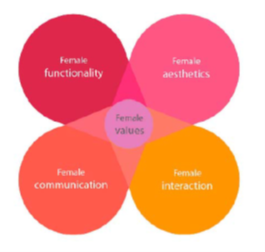“Why are there only 3 chairs?” I asked, “She’ll cook while the family sit & eat right?” the interior designer said in a matter-of-fact tone about breakfast counter.
Believe it or not, this is an excerpt from a real conversation that I had last week. What’s concerning is the impact gender-bias thinking and mindsets can have on building or product design. What if this designer was responsible for building a large residential building? How many families would be subtly influenced by a gender-bias design?
Societies perception of gender are (slowly) changing, and roles are being redefined. To support that change, buildings and products need to be created that are better designed to support and enable all genders. Helping to remove the many small obstacles that women face every day.
Can our spaces be more female friendly?
Simple things such as changing the office air conditioning temperature will help. Studies show that the formulae used to set building temperatures is from the 1960’s and based on male metabolic rates. Men may produce more heat than women, but men don’t represent 100% of the workforce. Meaning air-conditioning is usually too cool. Wasting energy, producing unnecessary emissions, and making women feel uncomfortable. Offices and metro’s in Singapore are a great example of this. In a tropical climate if you’re wearing a jacket indoors – it’s too cold.
When it comes to architecture, it’s clear the industry is severely lagging. The Bureau of Labour reports that only 25% of Architects are female – a figure which is true of both the USA and the UK. The percentage decreases when looking at management & senior leadership. Only 3 of the top 100 architecture companies are led by women, with less than 10 percent of leadership positions held by women.
Is change likely to happen quickly? Unfortunately the pipeline doesn’t paint a rosy picture. Figures from the National Council of Architectural Registration Boards (USA) show that only 36 per cent of new architects are women. Almost identical to the statistics from the UK.
“It’s a cultural attitude thinking that women and mothers are ineffective employees and are less committed or not as strong. This further shuts out women in the organisation.” – Dara Huang, Founder, Design Haus Liberty
Are your products designed with women in mind?
Product design isn’t significantly different. A study of 17,948 product designers in the US found that approximately 70% of product designers are men, and 70% are white. When looking at how many technology products are positioned, this isn’t surprising. Most advanced consumer electronic products like TV’s, sound systems and mobile phones are dominated by male design thinking & messaging.
Gender in product design needs to account for multiple dimensions such as value, function/benefit, interaction, aesthetic and communication. However majority of technology products today just focus on exterior aesthetic. A practice often referred to as “pinking”.
Making product design more equitable
That isn’t to say that buildings or products should be designed exclusively for either gender. Rather the respective industries need to keep female personas in mind when planning. UNESCO’s expert paper (K. Schroder et al. 2010) highlights some methods to help design products that are more female friendly:
- Awareness. Create awareness that tech products & buildings are often biased by male thinking.
- Female personas. Include female personas in your design brief and include these dimensions in your evaluations.
- Guidelines & Processes. Provide practical development guidelines & processes, that accommodate female users in both the design and testing phases of new products. Focusing on user driven approaches to innovation. Instead of innovation based purely on existing market insights – which propagates existing trends.
- Inspiration. There are abundant examples of technology produced by women, or innovations that make women’s lives better. Understanding what works (and why) can be a great motivator and help inspire different design ideas.
Importantly, gender neutral design makes financial sense. Changing roles will make products designed with all genders in mind, open to a much larger customer set. Evolving workforce demographics, mean spaces that are better crafted for women will enjoy greater workforce productivity (and attention from female leaders).
TLDR
Creating spaces and products that are better designed for women is an important part of gender equality. The world can’t wait for massive organizational change and equal representation in key industries for the changes to happen. Female personas need to become an important part of design philosophies and product testing. Designing for a wider audience isn’t just good for society, it’s good business that’ll benefit your bottom line.




